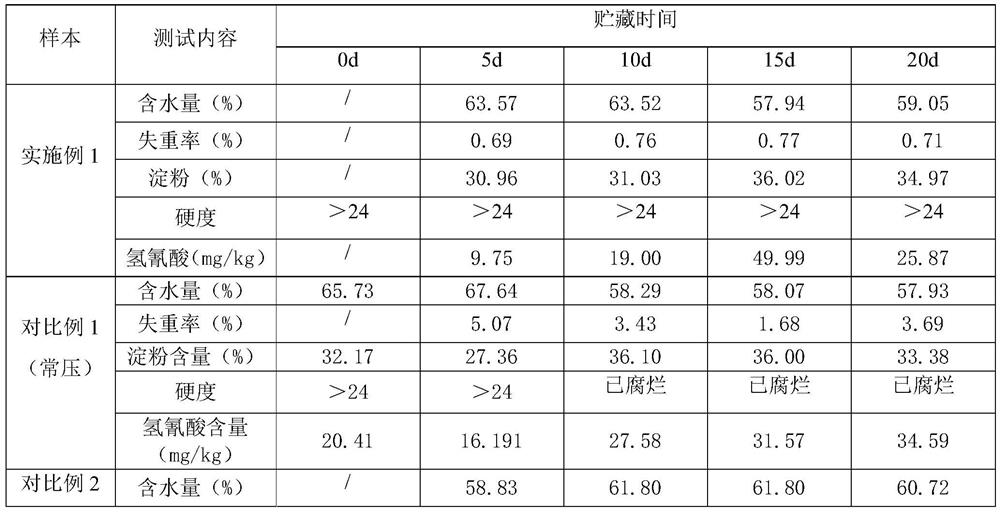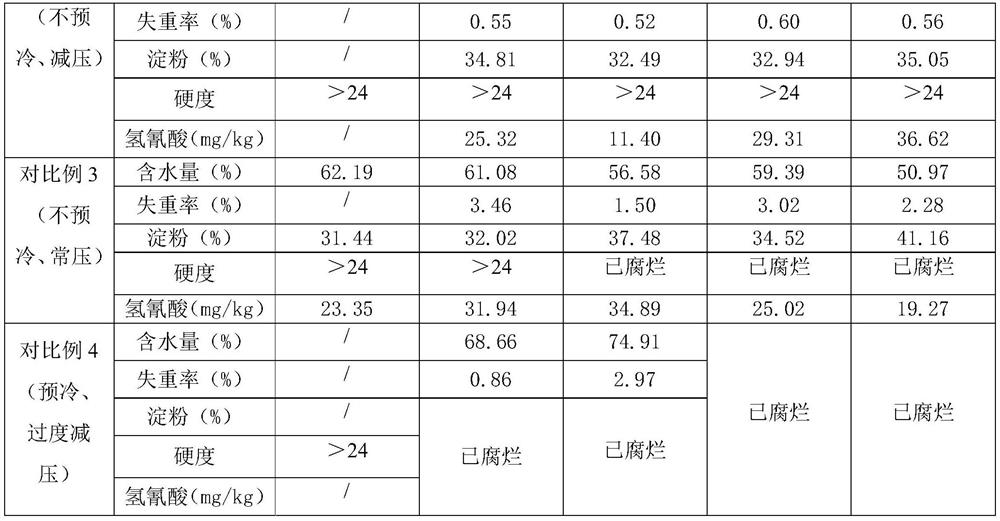Decompression storage method of tapioca roots
A technology of cassava and root tubers, which is applied in the direction of preservation of fruits/vegetables through freezing/refrigeration, food preservation, preservation of fruits/vegetables through radiation/electrical treatment, etc., which can solve problems such as high maintenance costs, loss of flavor, and decline in quality
- Summary
- Abstract
- Description
- Claims
- Application Information
AI Technical Summary
Problems solved by technology
Method used
Image
Examples
Embodiment 1
[0021] Embodiment 1 of the present invention provides a kind of decompression storage method of cassava tuber root, and it comprises the following specific operation steps:
[0022] 1) Cleaning: simply clean the fresh cassava roots, remove the surface silt and dry them for later use;
[0023] 2) Pre-cooling: the cassava tubers are pre-cooled with ice water at 4°C, and the pre-cooling time is 40 minutes to cool down the cassava tubers;
[0024] 3) Sterilization: place the precooled cassava root in the storage box after drying, and use a 5w ultraviolet lamp to sterilize the surface of the cassava root under airtight conditions, and the treatment time is 40min;
[0025] 4) Decompression: decompress the storage tank with a vacuum pump to reduce the pressure of the storage tank to 0.5 atmospheres;
[0026] 5) Ventilation: Pressurize and ventilate the storage tank every 1 hour, and the ventilation time is 5 minutes. After the air pressure in the storage tank and the external air pr...
Embodiment 2
[0029] Embodiment 2 of the present invention provides a kind of decompression storage method of cassava tuber root, and it comprises the following specific operation steps:
[0030] 1) Cleaning: simply clean the fresh cassava roots, remove the surface silt and dry them for later use;
[0031] 2) Pre-cooling: Pre-cooling the cassava tubers with ice water at a temperature of 6° C., the pre-cooling time is 60 minutes to cool down the cassava tubers;
[0032] 3) Sterilization: place the precooled cassava root in the storage box after drying, and use an 8w ultraviolet lamp to sterilize the surface of the cassava root under airtight conditions, and the treatment time is 30 minutes;
[0033] 4) Decompression: decompress the storage tank with a vacuum pump to reduce the pressure of the storage tank to 0.6 atmospheres;
[0034] 5) Ventilation: pressurize and ventilate the storage tank after every 3 hours, and the ventilation time is 8 minutes. After the air pressure in the storage tan...
Embodiment 3
[0037] Embodiment 1 of the present invention provides a kind of decompression storage method of cassava tuber root, and it comprises the following specific operation steps:
[0038] 1) Cleaning: simply clean the fresh cassava roots, remove the surface silt and dry them for later use;
[0039] 2) Pre-cooling: the cassava tubers are pre-cooled with ice water at a temperature of 9° C., and the pre-cooling time is 80 minutes to cool down the cassava tubers;
[0040] 3) Sterilization: place the precooled cassava root in the storage box after drying, and use a 10w ultraviolet lamp to sterilize the surface of the cassava root under airtight conditions, and the treatment time is 20 minutes;
[0041] 4) Decompression: decompress the storage tank with a vacuum pump to reduce the pressure of the storage tank to 0.7 atmospheres;
[0042] 5) Ventilation: Pressurize and ventilate the storage box after every 12 hours, and the ventilation time is 10 minutes. After the air pressure in the sto...
PUM
 Login to View More
Login to View More Abstract
Description
Claims
Application Information
 Login to View More
Login to View More - R&D
- Intellectual Property
- Life Sciences
- Materials
- Tech Scout
- Unparalleled Data Quality
- Higher Quality Content
- 60% Fewer Hallucinations
Browse by: Latest US Patents, China's latest patents, Technical Efficacy Thesaurus, Application Domain, Technology Topic, Popular Technical Reports.
© 2025 PatSnap. All rights reserved.Legal|Privacy policy|Modern Slavery Act Transparency Statement|Sitemap|About US| Contact US: help@patsnap.com


